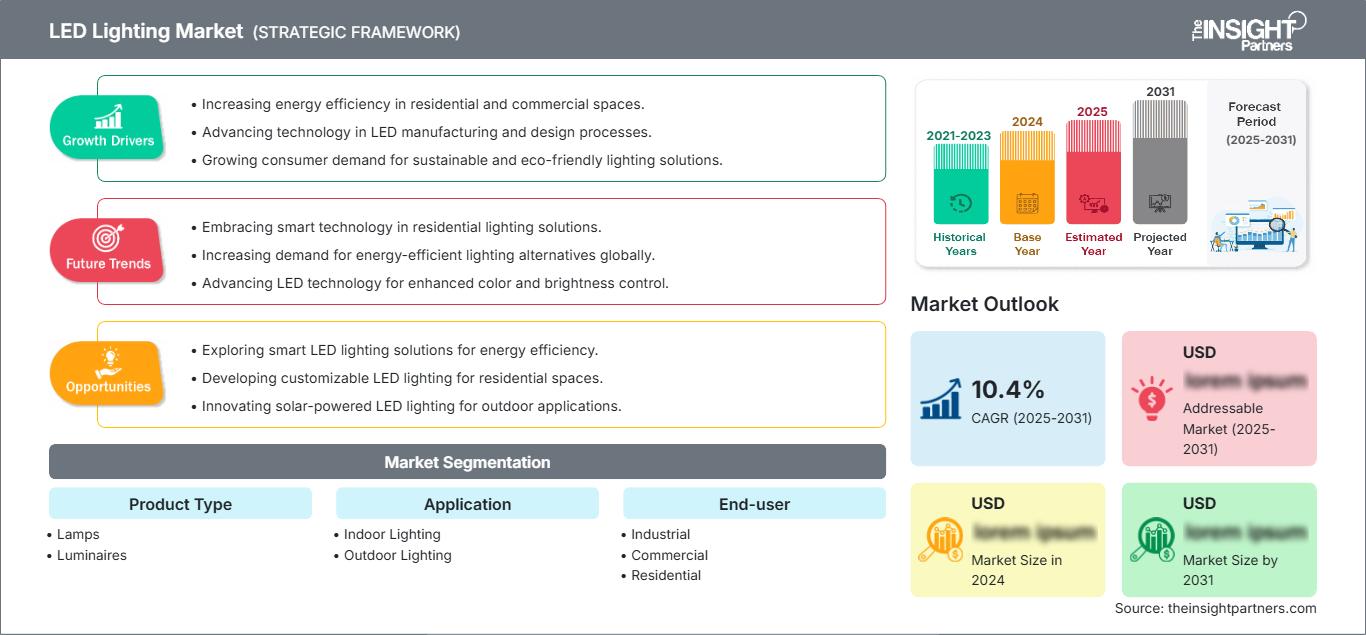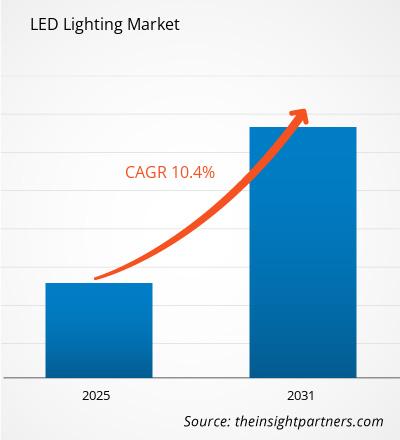Se prevé que el mercado de iluminación LED registre una tasa de crecimiento anual compuesta (TCAC) del 10,4% entre 2025 y 2031, con un tamaño de mercado que se expandirá de XX millones de dólares estadounidenses en 2024 a XX millones de dólares estadounidenses en 2031.
El informe se divide por tipo de producto (lámparas, luminarias), aplicación (iluminación interior, iluminación exterior) y usuario final (industrial, comercial, residencial, organismos gubernamentales). El informe ofrece el valor en USD para el análisis y los segmentos mencionados.
Finalidad del informe
El informe sobre el mercado de la iluminación LED, elaborado por The Insight Partners, tiene como objetivo describir el panorama actual y el crecimiento futuro, los principales factores impulsores, los desafíos y las oportunidades. Esto proporcionará información valiosa a diversos actores del sector, tales como:
- Proveedores/fabricantes de tecnología: Para comprender la evolución de la dinámica del mercado y conocer las posibles oportunidades de crecimiento, lo que les permitirá tomar decisiones estratégicas informadas.
- Inversores: Realizar un análisis exhaustivo de las tendencias relativas a la tasa de crecimiento del mercado, las proyecciones financieras del mercado y las oportunidades que existen a lo largo de la cadena de valor.
- Organismos reguladores: Regular las políticas y controlar las actividades en el mercado con el objetivo de minimizar los abusos, preservar la confianza de los inversores y mantener la integridad y la estabilidad del mercado.
Segmentación del mercado de iluminación LED
Tipo de producto
- Lámparas
- Luminarias
Solicitud
- Iluminación interior
- Iluminación exterior
Usuario final
- Industrial
- Comercial
- Residencial
- Organismos gubernamentales
Geografía
- América del norte
- Europa
- Asia-Pacífico
- América del Sur y Central
- Oriente Medio y África
Obtendrá personalización gratuita de cualquier informe, incluyendo partes de este informe, análisis a nivel de país y paquetes de datos de Excel. Además, podrá aprovechar excelentes ofertas y descuentos para empresas emergentes y universidades.
Mercado de iluminación LED: Perspectivas estratégicas

- Obtenga las principales tendencias clave del mercado que se describen en este informe.Esta muestra GRATUITA incluirá análisis de datos, que abarcarán desde tendencias de mercado hasta estimaciones y pronósticos.
Factores que impulsan el crecimiento del mercado de iluminación LED
- Mayor concienciación sobre la eficiencia energética: Uno de los principales impulsores del mercado de la iluminación LED es la creciente concienciación sobre la eficiencia energética tanto entre consumidores como entre empresas. Las luces LED consumen mucha menos energía que las bombillas incandescentes o fluorescentes tradicionales, lo que se traduce en facturas de electricidad más bajas y un menor impacto ambiental. A medida que los gobiernos de todo el mundo implementan normativas e incentivos para promover soluciones de iluminación energéticamente eficientes, los consumidores se inclinan cada vez más por la tecnología LED, impulsando así el crecimiento del mercado.
- Urbanización creciente y desarrollo de infraestructura: A medida que la urbanización continúa aumentando a nivel mundial, crece la demanda de soluciones de iluminación eficientes y confiables para la infraestructura urbana. Las ciudades invierten en sistemas de iluminación modernos para mejorar la seguridad pública, la estética y reducir el consumo de energía. La iluminación LED es especialmente idónea para entornos urbanos debido a su durabilidad, sus bajos requisitos de mantenimiento y su capacidad para proporcionar una iluminación de alta calidad. Esta tendencia hacia la urbanización y el desarrollo de infraestructura impulsa la adopción de soluciones de iluminación LED en ciudades de todo el mundo.
Tendencias futuras del mercado de iluminación LED
- Auge de las soluciones de iluminación inteligente: La tendencia hacia la iluminación inteligente está cobrando fuerza en el mercado de la iluminación LED. Gracias a la integración de la tecnología IoT, los sistemas de iluminación LED inteligentes permiten a los usuarios controlar la iluminación de forma remota mediante smartphones u otros dispositivos. Esta funcionalidad ofrece características como la regulación de la intensidad, el cambio de color y la programación, lo que proporciona a los usuarios mayor comodidad y una mejor gestión energética. Dado que los consumidores buscan cada vez más experiencias de iluminación personalizadas y eficientes, se prevé que la demanda de soluciones LED inteligentes siga creciendo.
- Enfoque en soluciones sostenibles y ecológicas: La sostenibilidad es una tendencia clave que influye en el mercado de la iluminación LED, ya que tanto consumidores como empresas priorizan los productos ecológicos. Los LED están libres de materiales peligrosos como el mercurio, común en la iluminación fluorescente tradicional, y tienen una huella de carbono mucho menor gracias a su eficiencia energética. Este creciente interés por las soluciones de iluminación sostenibles impulsa a los fabricantes a innovar y promover los beneficios ambientales de la tecnología LED, lo que a su vez impulsa el crecimiento del mercado.
Oportunidades de mercado en iluminación LED
- Adopción en aplicaciones comerciales e industriales: Los sectores comercial e industrial ofrecen importantes oportunidades para el mercado de la iluminación LED. Las empresas reconocen cada vez más las ventajas de la tecnología LED, como la reducción de los costes energéticos y de las necesidades de mantenimiento. Desde oficinas hasta plantas de producción, la transición a la iluminación LED es cada vez más frecuente, ya que las empresas buscan mejorar la eficiencia operativa y la sostenibilidad. Al centrarse en estos sectores, los fabricantes pueden aprovechar la creciente demanda de soluciones de iluminación energéticamente eficientes.
- Aplicaciones innovadoras en iluminación decorativa y arquitectónica: La versatilidad de la tecnología LED abre un sinfín de posibilidades en iluminación decorativa y arquitectónica. Gracias a los avances en la mezcla de colores, los efectos de iluminación dinámicos y la controlabilidad, los LED pueden utilizarse de forma creativa para realzar la estética tanto en espacios residenciales como comerciales. Esto incluye aplicaciones como iluminación ambiental, iluminación de acento e incluso instalaciones artísticas. Dado que los consumidores y diseñadores buscan cada vez más soluciones de iluminación únicas y personalizables, es probable que la demanda de productos LED innovadores para entornos decorativos crezca considerablemente.
Perspectivas regionales del mercado de iluminación LED
Los analistas de The Insight Partners han explicado en detalle las tendencias regionales y los factores que influyen en el mercado de la iluminación LED durante el período de previsión. Esta sección también analiza los segmentos del mercado de la iluminación LED y su distribución geográfica en Norteamérica, Europa, Asia Pacífico, Oriente Medio y África, y Sudamérica y Centroamérica.
Alcance del informe de mercado de iluminación LED
| Atributo del informe | Detalles |
|---|---|
| Tamaño del mercado en 2024 | XX millones de dólares estadounidenses |
| Tamaño del mercado para 2031 | XX millones de dólares estadounidenses |
| Tasa de crecimiento anual compuesto global (2025 - 2031) | 10,4% |
| Datos históricos | 2021-2023 |
| período de previsión | 2025-2031 |
| Segmentos cubiertos | Por tipo de producto
|
| Regiones y países cubiertos | América del norte
|
| Líderes del mercado y perfiles de empresas clave |
|
Densidad de los actores del mercado de iluminación LED: comprensión de su impacto en la dinámica empresarial
El mercado de la iluminación LED está creciendo rápidamente, impulsado por la creciente demanda de los usuarios finales debido a factores como la evolución de las preferencias de los consumidores, los avances tecnológicos y una mayor conciencia de los beneficios del producto. A medida que aumenta la demanda, las empresas amplían su oferta, innovan para satisfacer las necesidades de los consumidores y aprovechan las nuevas tendencias, lo que impulsa aún más el crecimiento del mercado.

- Obtenga una visión general de los principales actores del mercado de iluminación LED.
Puntos clave de venta
- Cobertura integral: El informe abarca de forma exhaustiva el análisis de productos, servicios, tipos y usuarios finales del mercado de iluminación LED, proporcionando una visión holística.
- Análisis de expertos: El informe se elabora a partir del profundo conocimiento de expertos y analistas del sector.
- Información actualizada: El informe garantiza su relevancia para el negocio gracias a su cobertura de información reciente y tendencias de datos.
- Opciones de personalización: Este informe se puede personalizar para satisfacer las necesidades específicas del cliente y adaptarse adecuadamente a las estrategias comerciales.
Por lo tanto, el informe de investigación sobre el mercado de la iluminación LED puede ayudar a liderar el proceso de análisis y comprensión del panorama de la industria y sus perspectivas de crecimiento. Si bien existen algunas preocupaciones válidas, los beneficios generales de este informe tienden a superar las desventajas.
- Análisis histórico (2 años), año base, pronóstico (7 años) con CAGR
- Análisis PEST y FODA
- Tamaño del mercado, valor/volumen: global, regional y nacional
- Industria y panorama competitivo
- Conjunto de datos de Excel
Informes recientes
Testimonios
Razón para comprar
- Toma de decisiones informada
- Comprensión de la dinámica del mercado
- Análisis competitivo
- Información sobre clientes
- Pronósticos del mercado
- Mitigación de riesgos
- Planificación estratégica
- Justificación de la inversión
- Identificación de mercados emergentes
- Mejora de las estrategias de marketing
- Impulso de la eficiencia operativa
- Alineación con las tendencias regulatorias




















 Obtenga una muestra gratuita para - Mercado de iluminación LED
Obtenga una muestra gratuita para - Mercado de iluminación LED